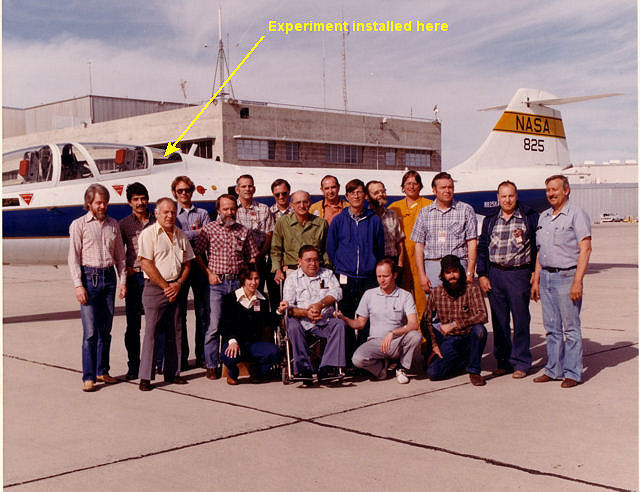
Back row from left: Sven Wallin (SSC), Hamid Shahani (scientist), fifth from left pilot Steve Ishmael, sixth from
left is flight engineer Victor Horton. Front row from left: Marta Bohn Meyer (NASA), Merle Economu (NASA),
Rolf Jönsson (SSC)...
Sven Grahn
A series
of experiments to produce metal foam and study the mechanism of pore growth were
performed by a graduate student, Hamid Shahani, at the Department of
Casting of Metals at the Royal Institute of Technology in Stockholm in
co-operation with the Swedish Space Corporation
(SSC) and NASA in February 1982. The project was sponsored by the
Swedish Board for Space Activities (nowadays The
Swedish National Space Board
).
The experiments were flown on parabolic fllights using an
F-104 Starfighter airplane at NASA's Dryden Flight
Research Facility
.
The
airplane ascended to 72,000 feet (22 km)
and achieved microgravity (acceleration levels around 10-2g) for 55-60 seconds. Three flights were flown per
day using the same experiment equipment with different
samples.
 Back row from left: Sven Wallin (SSC), Hamid Shahani (scientist), fifth from left pilot Steve Ishmael, sixth from left is flight engineer Victor Horton. Front row from left: Marta Bohn Meyer (NASA), Merle Economu (NASA), Rolf Jönsson (SSC)... |
More pictures from the development of the experiment and the work at Dryden Flight Research Facility can be seen here.
The department for metal casting at the Royal Institute of Technology in Stockholm, Sweden, where Mr Shahani won his doctor's degree has a long history of experiments in microgravity starting in 1977 when alloy solidification experiments were flown in the Swedish experiment module on the german Texus sounding rocket launched from Esrange in Sweden.
The equipment which was used in the Starfighter experiment was mainly the same as the one used in a previous sounding rocket flight (the Swedish combined astronomy and microgravity rocket PIRAT launched from Esrange, Sweden on 30 September 1981). A motor-driven camera was added to the airplane experiment in order to photograph the process every 0.3 seconds. The equipment that was installed behind and below the back seat of the Starfighter can be seen below.
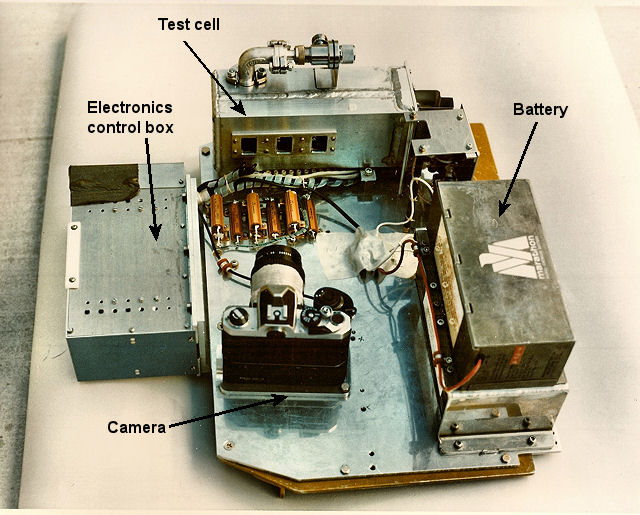 |
|
In total nine flights were performed with three samples in each flight so a total of 27 samples were processed. The samples were produced in the same way as in the sounding rocket experiments. The samples were made of Al, Al-4% Ti and Al- 10 % Fe with different hydrogen content (that is the alloys were processed at different hydrogen pressure levels). Embedded in each sample pellet was a heater consisting of the filament from a halogen lamp. The flight crew turned on the experiment when microgravity was achieved and siwtched it off before g-levels increased again. An electronics control box operated the experiment automatically.
Three samples were assembled into the experiment test cell. The
temperature of each sample was monitored by a chromel-alumel thermocouple. In addition current
through the heaters, the pressure in the experiment test cell and ambient temperature
inside the experiment test cell were monitored. The g-levels were also
monitored in three axes during the flight and relayed to
the ground together with the other measurements by the Starfighter's VHF telemetry transmitter.
The experiment test cell was filled with helium to either 0.1 or 1 atm. For Al-4 % Ti
three extra samples were run at 0.4 atm.
The camera started to take pictures nine seconds efter the experiment was turned on by the
flight crew. At the same time six lamps were switched on to illuminate the samples.
An Ilford 400 ASA film with 72 frames was used and each picture
on the film included the three samples. The camera had a view
through the three glass windows of the experiment test cell. After a flight
the film was developed and printed. Photos from each experiment series were assembled
together in order to follow the process of melting and expansion of the
samples.
Modifications were needed to the experiment after its arrival at the Dryden Flight Research Facility (DFRF) (see (2)). For example, SSC had intended to use lead-acid batteries to power the experiment but they were found to be prone to explosion if subjected to vaccum. DFRF made high-capacity Ni-Cd batteries available.
When I started researching this web article I very much doubted that any hardware had survived the almost 28 years that have passed (in late 2009) since the flights at the DFRF. But when I asked SSC engineer Sven Wallin who took part in the activities at the DFRF back in 1982 he pulled out the experiment test cell into which the samples were mounted and then processed in an inert helium atmosphere. A picture of the test cell taken in November 2009 is shown below. Mr Wallin also contributed the pictures and documents that this article is based on. I also found that the camera used was and is - the property of another SSC engineer, Mr Per Holm. As you can see below, the camera is still around the lab and has an interesting sticker on the bottom.
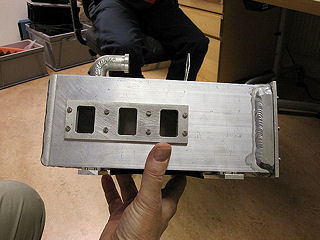 |
 |
|
Kept for sentimental reasons? The experiment test cell used in 1982 is still around in 2009! | |
|
| |
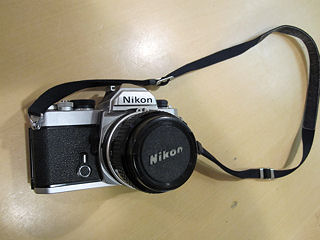 |
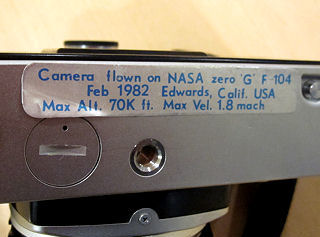 |
|
Per Holm's old Nikon is still around too - with an interesting sticker! | |
Each flight lasted 20-25 minutes. Each microgravity run started
at about 28, 000 feet (8540 m) with a speed of Mach 1.85. A 3-g pullup
to a 48o pitch angle preceded
the microgravity phase. The plane reached about 72,000 feet (22 km) and
then descended to 52,000 feet (16 km) where the microgravity phase
ended. The ground distance covered during the microgravity phase was about 15
km. It seems that the flights were planned som that, if no pull-up was possible
at the end of microgravity, the crew would eject and the plane wreckage would
impact within the Edwards AFB perimeter.
The acceleration levels and flight
events during the last flight is shown in the pen recording below. The three
experiment-related events noted in the graph are: "Experiment turned on", "End
of heating", and "Solidification". Acceleration levels -1 g, 0 g, and +4 g are
also shown in the graph.
|
|
|
|
Nine flights were performed under the direction of operations engineer Marta Bohn Meyer by pilot Stephen D Ishmael and flight engineer Victor Horton. The crew wore a pressure suits. Eight of the flights were made under good microgravity conditions. The details of flight operations can be found in (2) and the text of that source is found here .
| Date | Take-off time | Remarks |
| 12 February 1982 | 0900 local time | 0.25 g, telemetry problem |
| 23 February 1982 | 0900 local time | 55-59 seconds microgravity |
|
-"- |
1300 local time | 55-59 seconds microgravity |
| 24 February 1982 | 0830 local time | Cirrus at Flight Level 250 |
|
-"- |
1030 local time |
-"- |
|
-"- |
1230 local time |
-"- |
| 26 February 1982 | 0900 local time | |
|
-"- |
1030 local time | |
|
-"- |
1230 local time | Peak altitude 72,000 ft (22 km) |
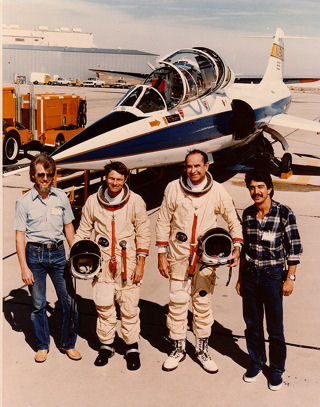
From the left: SSC engineer Sven Wallin, pilot Steve Ishmael, flight engineer Vic Horton, scientist Hamid Shahani.
 It seems that NASA Dryden
continued to fly microgravity flights for scientists. In (3) we can
read that flights were planned later in the spring of 1982 to support "iron
alloy" experiments for the John Deere company. In (2) it seems
as if the Swedish experiment was one of the early science flights, if not
the first?
It seems that NASA Dryden
continued to fly microgravity flights for scientists. In (3) we can
read that flights were planned later in the spring of 1982 to support "iron
alloy" experiments for the John Deere company. In (2) it seems
as if the Swedish experiment was one of the early science flights, if not
the first?![]()